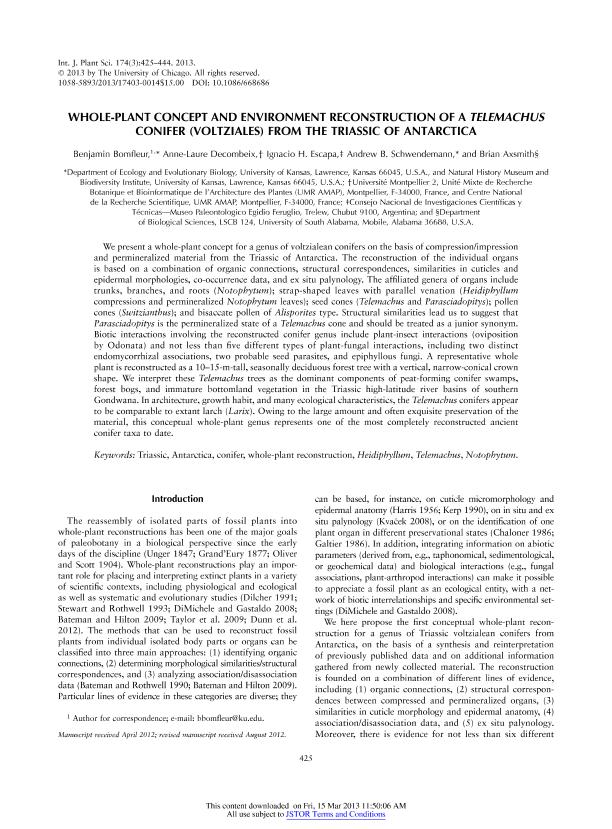Artículo
Whole-Plant Concept and Environment Reconstruction of a Telemachus Conifer (Voltziales) from the Triassic of Antarctica
Bomfleur, Benjamin; Decombeix, Anne Laure; Escapa, Ignacio Hernan ; Schwendemann, Andrew; Axsmith, Brian
; Schwendemann, Andrew; Axsmith, Brian
 ; Schwendemann, Andrew; Axsmith, Brian
; Schwendemann, Andrew; Axsmith, Brian
Fecha de publicación:
07/2013
Editorial:
University of Chicago Press
Revista:
International Journal of Plant Sciences
ISSN:
1058-5893
Idioma:
Inglés
Tipo de recurso:
Artículo publicado
Clasificación temática:
Resumen
We present a whole-plant concept for a genus of voltzialean conifers on the basis of compression/impression and permineralized material from the Triassic of Antarctica. The reconstruction of the individual organs is based on a combination of organic connections, structural correspondences, similarities in cuticles and epidermal morphologies, co-occurrence data, and ex situ palynology. The affiliated genera of organs include trunks, branches, and roots (Notophytum); strap-shaped leaves with parallel venation (Heidiphyllum compressions and permineralized Notophytum leaves); seed cones (Telemachus and Parasciadopitys); pollen cones (Switzianthus); and bisaccate pollen of Alisporites type. Structural similarities lead us to suggest that Parasciadopitys is the permineralized state of a Telemachus cone and should be treated as a junior synonym. Biotic interactions involving the reconstructed conifer genus include plant-insect interactions (oviposition by Odonata) and not less than five different types of plant-fungal interactions, including two distinct endomycorrhizal associations, two probable seed parasites, and epiphyllous fungi. A representative whole plant is reconstructed as a 10–15-m-tall, seasonally deciduous forest tree with a vertical, narrow-conical crown shape. We interpret these Telemachus trees as the dominant components of peat-forming conifer swamps, forest bogs, and immature bottomland vegetation in the Triassic high-latitude river basins of southern Gondwana. In architecture, growth habit, and many ecological characteristics, the Telemachus conifers appear to be comparable to extant larch (Larix). Owing to the large amount and often exquisite preservation of the material, this conceptual whole-plant genus represents one of the most completely reconstructed ancient conifer taxa to date.
Archivos asociados
Licencia
Identificadores
Colecciones
Articulos(CCT-CENPAT)
Articulos de CTRO.CIENTIFICO TECNOL.CONICET - CENPAT
Articulos de CTRO.CIENTIFICO TECNOL.CONICET - CENPAT
Citación
Bomfleur, Benjamin; Decombeix, Anne Laure; Escapa, Ignacio Hernan; Schwendemann, Andrew; Axsmith, Brian; Whole-Plant Concept and Environment Reconstruction of a Telemachus Conifer (Voltziales) from the Triassic of Antarctica; University of Chicago Press; International Journal of Plant Sciences; 174; 3; 7-2013; 425-444
Compartir
Altmétricas



